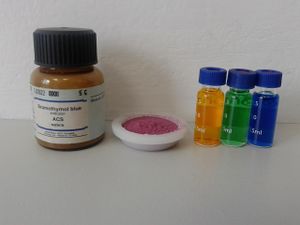Difference between revisions of "Bromothymol blue"
(Created page with "{{Chembox | Name = Bromothymol blue | Reference = | IUPACName = | PIN = | SystematicName = | OtherNames = BTB<br>3,3'-Dibromothymolsulfonphthalein<br>Dibromothymolsulfophthale...") |
(→Relevant Sciencemadness threads) |
||
| (6 intermediate revisions by the same user not shown) | |||
| Line 48: | Line 48: | ||
| Section2 = {{Chembox Properties | | Section2 = {{Chembox Properties | ||
| AtmosphericOHRateConstant = | | AtmosphericOHRateConstant = | ||
| − | | Appearance = | + | | Appearance = Colorless solid (fresh)<br>Lilac/mauve solid (old) |
| BoilingPt = | | BoilingPt = | ||
| BoilingPtC = | | BoilingPtC = | ||
| Line 114: | Line 114: | ||
===Chemical=== | ===Chemical=== | ||
Bromothymol blue turns yellow in solutions with pH < 6.5, green between 6.5 - 7.2 and blue at pH > 7.2. | Bromothymol blue turns yellow in solutions with pH < 6.5, green between 6.5 - 7.2 and blue at pH > 7.2. | ||
| + | |||
| + | Bromothymol blue slowly oxidizes in air, turning lilac/purple, though this does not affect its pH sensitivity. | ||
===Physical=== | ===Physical=== | ||
| − | Bromothymol blue is an odorless | + | Bromothymol blue is an odorless colorless solid, that turns lilac/purple over long periods of time in contact with air. It is almost insoluble in water, but soluble in aq. alkali, [[acetone]], [[methanol]], [[diethyl ether]] and [[ethanol]], slightly soluble in aq. [[ammonia]], [[chloroform]], [[isopropanol]] and insoluble in [[glycerol]] as well as non-polar solvents such as [[hexane]], [[petroleum ether]]. |
==Availability== | ==Availability== | ||
| Line 122: | Line 124: | ||
==Preparation== | ==Preparation== | ||
| − | + | Bromothymol blue can be synthesized by addition of elemental [[bromine]] to [[thymol blue]] in a solution in glacial [[acetic acid]]. Thymol blue itself can be prepared by reacting [[saccharin]] with [[thymol]]. | |
| + | |||
| + | Bromothymol blue however, is best purchased than synthesized, as it's a lot cheaper. | ||
==Projects== | ==Projects== | ||
| Line 132: | Line 136: | ||
===Storage=== | ===Storage=== | ||
| − | + | Bromothymol blue should be kept in closed bottles, away from corrosive vapors. | |
===Disposal=== | ===Disposal=== | ||
| Line 140: | Line 144: | ||
<references/> | <references/> | ||
===Relevant Sciencemadness threads=== | ===Relevant Sciencemadness threads=== | ||
| + | *[http://www.sciencemadness.org/talk/viewthread.php?tid=82156 Is bromothymol blue air-sensitive?] | ||
*[http://www.sciencemadness.org/talk/viewthread.php?tid=14894 How to prepare universal indicator - a recipie] | *[http://www.sciencemadness.org/talk/viewthread.php?tid=14894 How to prepare universal indicator - a recipie] | ||
| + | *[http://www.sciencemadness.org/talk/viewthread.php?tid=20276 Identifying Unknown Compounds in a Lab] | ||
[[Category:Chemical compounds]] | [[Category:Chemical compounds]] | ||
| Line 146: | Line 152: | ||
[[Category:Aromatic compounds]] | [[Category:Aromatic compounds]] | ||
[[Category:Dyes]] | [[Category:Dyes]] | ||
| + | [[Category:Triarylmethane dyes]] | ||
[[Category:PH indicators]] | [[Category:PH indicators]] | ||
Latest revision as of 19:17, 23 November 2023
 Bromothymol blue in solid form and as solution at pH < 6.5 (yellow), pH 6.5-7.2 (green) and pH > 7.2 (blue)
| |
| Names | |
|---|---|
| Other names
BTB
3,3'-Dibromothymolsulfonphthalein Dibromothymolsulfophthalein | |
| Properties | |
| C27H28Br2O5S | |
| Molar mass | 624.38 g/mol |
| Appearance | Colorless solid (fresh) Lilac/mauve solid (old) |
| Odor | Odorless |
| Density | 1.25 g/cm3 |
| Melting point | 202 °C (396 °F; 475 K) (decomposes) |
| Boiling point | Decomposes |
| Slightly soluble in water | |
| Solubility | Soluble in acetone, diethyl ether, ethanol, methanol Poorly soluble in aq. ammonia Slightly soluble in chloroform, isopropanol Insoluble in glycerol, hexane, petroleum ether |
| Vapor pressure | ~0 mmHg (20 °C) |
| Hazards | |
| Safety data sheet | AcrosOrganics |
| Except where otherwise noted, data are given for materials in their standard state (at 25 °C [77 °F], 100 kPa). | |
| Infobox references | |
Bromothymol blue (IUPAC: 4,4′-(1,1-Dioxido-3H-2,1-benzoxathiole-3,3-diyl)bis(2-bromo-6-isopropyl-3-methylphenol)) is a pH indicator, commonly used for determining the neutral pH of a solution, as the indicator turns the solution green in a very narrow range (6.5-7.2). It has the chemical formula C27H28Br2O5S.
Contents
Properties
Chemical
Bromothymol blue turns yellow in solutions with pH < 6.5, green between 6.5 - 7.2 and blue at pH > 7.2.
Bromothymol blue slowly oxidizes in air, turning lilac/purple, though this does not affect its pH sensitivity.
Physical
Bromothymol blue is an odorless colorless solid, that turns lilac/purple over long periods of time in contact with air. It is almost insoluble in water, but soluble in aq. alkali, acetone, methanol, diethyl ether and ethanol, slightly soluble in aq. ammonia, chloroform, isopropanol and insoluble in glycerol as well as non-polar solvents such as hexane, petroleum ether.
Availability
Bromothymol blue can be purchased online or from chemical suppliers. It can be found on eBay.
Preparation
Bromothymol blue can be synthesized by addition of elemental bromine to thymol blue in a solution in glacial acetic acid. Thymol blue itself can be prepared by reacting saccharin with thymol.
Bromothymol blue however, is best purchased than synthesized, as it's a lot cheaper.
Projects
- pH indicator
Handling
Safety
Bromothymol blue is irritant and should be handled with care.
Storage
Bromothymol blue should be kept in closed bottles, away from corrosive vapors.
Disposal
Bromothymol blue can be neutralized with a strong oxidizing solution, such as chromic acid, Fenton's reagent or piranha solution, followed by neutralization and then poured down the drain after all the bromothymol blue has been neutralized. Since most of bromothymol blue neutralized this way is either as solution or traces, there is little risk of splashing.